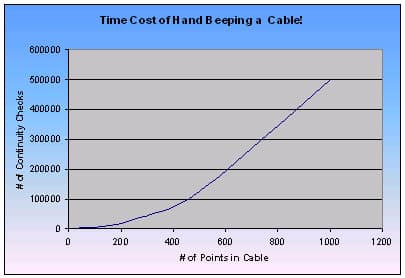Verify Cable Tester Programs BEFORE Testing
In order to assure valid testing on your harness or cable tester you must verify that it is programmed correctly BEFORE you begin testing cables. The most effective workflow for testing cables and harnesses on your Cirris tester is by following the 3-step process:
- Create Cable Testing Program (Learn, Enter Manually, or Import)
- Verify
- Test
For a New (Never Before Verified) Test Program
| Source for Test Programs. | Risks | How to Verify (Double) Check) to Assure Correct Programing. | How to Simplify Future Verfication |
|---|---|---|---|
|
|
|
|
|
|
|
|
|
|
Same as above. | Same as above. |
For a Repeat (Previously Verified and Documented) Test Program.
| Source for Test Programs. | Risks | How to Recognize Incorrect Test Programs | How to Resolve |
|---|---|---|---|
|
|
|
|
|
|
|
|
Key Points
- Small assemblies: (few points) are easy to verify. Use the Learn, Verify, Test approach.
- Large assemblies: (many points) are more difficult to verify. Where possible, use known-good electronic files and import/download into the tester.
- Assemblies with components: (resistors, diodes, capacitors, etc.). Most Cirris testers can LEARN components in an assembly along with the wiring pattern. They will always make their best guess as to type and value of components but you MUST verify that learned components are of the desired value, and in the correct location, in your test program. Note: When you have components in parallel with other components, the measured values can be different than the actual component values.
- Known Good or Golden Samples: They don’t exist! There is no such thing as a known good sample, only presumed good. Even if you use a presumed good sample to program the tester you MUST verify correct programming by one of the methods described above.
- Hand Beeping: a sample assembly does NOT guarantee that it is a known good! Don’t ever waste valuable time beeping out the assembly. When your Cirris tester learns the assembly it beeps it out for you. In a few seconds, your Cirris tester will present you with a complete listing of connections that you can use to VERIFY against the specification. Beeping out by hand could take hours when done properly* and can involve hundreds of evaluations for even relatively simple assemblies. Sorting out even minor discrepancies can be very irritating.
* Remember that you must not only check that J1 is connected to P1, but also that J1 is NOT connected to J2 and J3 and J4 and so on. How many questions do you answer when you beep them out? Just two. Is it connected? Is it not connected? How many times you must answer these two questions depends on the number of test points in all the connectors in the assembly. Beeping out a simple 9-pin serial cable requires 153 questions and answers. A slightly bigger parallel printer cable, with 25 contacts on one end and 36 on the other, requires 1830 questions and answers! The table and graphic below illustrate this point.
| # of Test Points in Cable | # of Continuity Checks |
|---|---|
| 2 | 1 |
| 5 | 10 |
| 10 | 45 |
| 20 | 190 |
| 50 | 1225 |
| 100 | 4950 |
| 250 | 31,125 |
| 500 | 124,750 |
| 1000 | 499,500 |
| 2000 | 1,999,000 |


